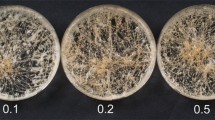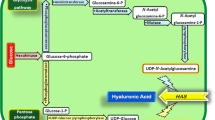Abstract
Arabidopsis hairy roots were used to produce human gastric lipase. When treated with 2,4-D, the hairy roots developed into thick organs that produced more protein than untreated roots. This was first assessed using green fluorescent protein-producing root lines from which the protein diffused into the culture medium. When growing hairy roots which express the human gastric lipase gene, very little lipase was found in the medium. Incubating the roots in a low pH buffer resulted in lipase diffusion into the buffer, avoiding the need for grinding. The activity of the enzyme on 4-methylumbellireryl-oleate and on tributyrin was determined. Approximately 6000 units of enzyme were recovered per gram of root. The enzyme was also extracted from freeze-dried roots before and after a 2-month storage period at room temperature. This work demonstrates the relevance of Arabidopsis hairy roots for the production of human gastric lipase.




Similar content being viewed by others
Abbreviations
- 2,4-D:
-
2,4-Dichlorophenoxyacetic acid
- BCA:
-
Bicinchoninic acid
- BSA:
-
Bovine serum albumin
- hGL:
-
Human gastric lipase
- MU:
-
4-Methylumbellirerone
- MUO:
-
4-Methylumbellireryl-oleate
References
Hellwig, S., Drossard, J., Twyman, R. M., & Fischer, R. (2004). Plant cell cultures for the production of recombinant proteins. Nature Biotechnology, 22, 1415–1422.
Stoger, E., Ma, J. K. C., Fischer, R., & Christou, P. (2005). Sowing the seeds of success: Pharmaceutical proteins from plants. Current Opinion in Biotechnology, 16, 167–173.
Xu, J., Dolan, M. C., Medrano, G., Cramer, C. L., & Weathers, P. J. (2012). Green factory: Plants as bioproduction platforms for recombinant proteins. Biotechnology Advances, 30, 1171–1184.
Ma, J. K. C., Drossard, J., Lewis, D., Altmann, F., Boyle, J., Christou, P., et al. (2015). Regulatory approval and a first-in-human phase I clinical trial of a monoclonal antibody produced in transgenic tobacco plants. Plant Biotechnology Journal, 13, 1106–1120.
D’Aoust, M. A., Couture, M. M. J., Charland, N., Trépanier, S., Landry, N., Ors, F., et al. (2010). The production of hemagglutinin-based virus-like particles in plants: A rapid, efficient and safe response to pandemic influenza. Plant Biotechnology Journal, 8, 607–619.
Sainsbury, F., & Lomonossoff, G. P. (2014). Transient expressions of synthetic biology in plants. Current Opinion in Plant Biology, 19, 1–7.
Fujiuchi, N., Matoba, N., & Matsuda, R. (2016). Environment control to improve recombinant protein yields in plants based on Agrobacterium-mediated transient gene expression. Frontiers in Bioengineering and Biotechnology, 4, 23.
Gaume, A., Komarnytsky, S., Borisjuk, N., & Raskin, I. (2003). Rhizosecretion of recombinant proteins from plant hairy roots. Plant Cell Reports, 21, 1188–1193.
Sabalza, M., Christou, P., & Capell, T. (2014). Recombinant plant-derived pharmaceutical proteins: current technical and economic bottlenecks. Biotechnology Letters, 36, 2367–2379.
Maxmen, A. (2012). Drug-making plant blooms. Nature, 485, 160.
Shaaltiel, Y., Gingis-Velitski, S., Tzaban, S., Fiks, N., Tekoah, Y., & Aviezer, D. (2015). Plant-based oral delivery of ß-glucocerebrosidase as an enzyme replacement therapy for Gaucher’s disease. Plant Biotechnology Journal, 13, 1033–1040.
Sack, M., Hofbauer, A., Fischer, R., & Stoger, E. (2015). The increasing value of plant-made proteins. Current Opinion in Biotechnology, 32, 163–170.
Yamamoto, T., Hoshikawa, K., Ezura, K., Okazawa, R., Fujita, S., Takaoka, M., et al. (2018). Improvement of the transient expression system for production of recombinant proteins in plants. Scientific Reports, 8, 4755.
Georgiev, M. I., Agostini, E., Ludwig-Müller, J., & Xu, J. (2012). Genetically transformed roots: from plant disease to biotechnological resource. Trends in Biotechnology, 30, 528–537.
Aird, E. L. D., Hamill, J. D., & Rhodes, M. J. C. (1988). Cytogenetic analysis of hairy root cultures from a number of plant species transformed by Agrobacterium rhizogenes. Plant Cell, Tissue and Organ Culture, 15, 47–57.
Häkkinen, S. T., Moyano, E., Cusido, R. M., & Oksman-Caldentey, K. M. (2016). Exploring the metabolic stability of engineered hairy roots after 16 years maintenance. Frontiers in Plant Science, 7, 1486.
Sun, J., Ma, L., San, K. Y., & Peebles, C. A. M. (2017). Still stable after 11 years: A Catharanthus roseus hairy root line maintains inducible expression of anthranilate synthase. Biotechnology Progress, 33, 66–69.
Joh, L. D., Wroblewski, T., Ewing, N. N., & VanderGheynst, J. S. (2005). High-level transient expression of recombinant protein in lettuce. Biotechnology and Bioengineering, 91, 861–871.
Clarke, J. L., Paruch, L., Dobrica, M. O., Caras, I., Tucureanu, C., Onu, A., et al. (2017). Lettuce-produced hepatitis C virus E1E2 heterodimer triggers immune responses in mice and antibody production after oral vaccination. Plant Biotechnology Journal, 15, 1611–1621.
Shaaltiel, Y., Bartfeld, D., Hashmueli, S., Baum, G., Brill-Almon, E., Galili, G., et al. (2007). Production of glucocerebrosidase with terminal mannose glycans for enzyme replacement therapy of Gaucher’s disease using a plant cell system. Plant Biotechnology Journal, 5, 579–590.
Huet, Y., Ele Ekouna, J. P., Caron, A., Mezreb, K., Boitel-Conti, M., & Guerineau, F. (2014). Production and secretion of a heterologous protein by turnip hairy roots with superiority over tobacco hairy roots. Biotechnology Letters, 36, 181–190.
Cardon, F., Pallisse, R., Bardor, M., Caron, A., Vanier, J., Ele Ekouna, J. P., et al. (2019). Brassica rapa hairy root based expression system leads to the production of highly homogenous and reproducible profiles of recombinant human alpha-l-iduronidase. Plant Biotechnology Journal, 17, 505–516.
von Schaewen, A., Jeong, I. S., Rips, S., Fukudome, A., Tolley, J., Nagashima, Y., et al. (2018). Improved recombinant protein production in Arabidopsis thaliana. Plant Signaling & Behavior, 13, e1486149.
Butaye, K. M. J., Goderis, I. J. W. M., Wouters, P. F. J., Pues, J. M. T. G., Delauré, S. L., Broekaert, W. F., et al. (2004). Stable high-level transgene expression in Arabidopsis thaliana using gene silencing mutants and matrix attachment regions. The Plant Journal, 39, 440–449.
Mai, N. T. P., Boitel-Conti, M., & Guerineau, F. (2016). Arabidopsis thaliana hairy roots for the production of heterologous proteins. Plant Cell, Tissue and Organ Culture, 127, 489–496.
Ele Ekouna, J. P., Boitel-Conti, M., Lerouge, P., Bardor, M., & Guerineau, F. (2017). Enhanced production of recombinant human gastric lipase in turnip hairy roots. Plant Cell, Tissue and Organ Culture, 131, 601–610.
Lonoce, C., Marusic, C., Morrocchi, E., Salzano, A. M., Scaloni, A., Novelli, F., et al. (2019). Enhancing the secretion of a glyco-engineered anti-CD20 scFv-Fc antibody in hairy root cultures. Biotechnology Journal, 14, e1800081.
Aloulou, A., & Carrière, F. (2008). Gastric lipase: an extremophilic interfacial enzyme with medical applications. Cellular and Molecular Life Sciences, 65, 851–854.
Tschofen, M., Knopp, D., Hood, E., & Stöger, E. (2016). Plant molecular farming: Much more than medicines. Annual Review of Analytical Chemistry, 9, 271–294.
Peragine, A., Yoshikawa, M., Wu, G., Albrecht, H. L., & Poethig, R. S. (2004). SGS3 and SGS2/SDE1/RDR6 are required for juvenile development and the production of trans-acting siRNAs in Arabidopsis. Genes & Development, 18, 2368–2379.
Bradford, M. (1976). A rapid and sensitive method for the quantitation of microgram quantities of protein utilizing the principle of protein-dye binding. Analytical Biochemistry, 72, 248–254.
Smith, P. K., Krohn, R. I., Hermanson, G. T., Mallia, A. K., Gartner, F. H., Provenzano, M. D., et al. (1985). Measurement of protein using bicinchoninic acid. Analytical Biochemistry, 150, 76–85.
Gargouri, Y., Pieroni, G., Riviere, C., Sauniere, J. F., Lowe, P. A., Sarda, L., et al. (1986). Kinetic assay of human gastric lipase on short- and long-chain triacylglycerol emulsions. Gastroenterology, 91, 919–925.
Kang, D., Gho, Y. S., Suh, M., & Kang, C. (2002). Highly sensitive and fast protein detection with Coomassie brilliant blue in sodium dodecyl sulfate-polyacrylamide gel electrophoresis. Bulletin of the Korean Chemical Society, 23, 1511–1512.
Atta, R., Laurens, L., Boucheron-Dubuisson, E., Guivarch, A., Carnero, E., Giraudat-Pautot, V., et al. (2009). Pluripotency of Arabidopsis xylem pericycle underlies shoot regeneration from root and hypocotyl explants grown in vitro. The Plant Journal, 57, 626–644.
Smetana, O., Mäkilä, R., Lyu, M., Amiryousefi, A., Sanchez Rodríguez, F., Wu, M. F., et al. (2019). High levels of auxin signalling define the stem-cell organizer of the vascular cambium. Nature, 565, 485–489.
Sams, L., Amara, S., Chakroun, A., Coudre, S., Paume, J., Giallo, J., et al. (2017). Constitutive expression of human gastric lipase in Pichia pastoris and site-directed mutagenesis of key lid-stabilizing residues. Biochimica et Biophysica Acta - Molecular and Cell Biology of Lipids, 1862, 1025–1034.
Mokrzycki-Issartel, N., Bouchon, B., Farrer, S., Berland, P., Laparra, H., Madelmont, J. C., et al. (2003). A transient tobacco expression system coupled to MALDI-TOF-MS allows validation of the impact of differential targeting on structure and activity of a recombinant therapeutic glycoprotein produced in plants. FEBS Letters, 552, 170–176.
Zhong, Q., Gu, Z., & Glatz, C. E. (2006). Extraction of recombinant dog gastric lipase from transgenic corn seed. Journal of Agriculture and Food Chemistry, 54, 8086–8092.
Vardakou, M., Sainsbury, F., Rigby, N., Mulholland, F., & Lomonossoff, G. P. (2012). Expression of active recombinant human gastric lipase in Nicotiana benthamiana using the CPMV-HT transient expression system. Protein Expression and Purification, 81, 69–74.
Sapan, C. V., Lundblad, R. L., & Price, N. C. (1999). Colorimetric protein assay techniques. Biotechnology and Applied Biochemistry, 29, 99–108.
Sarmah, N., Revathi, D., Sheelu, G., Yamuna Rani, K., Sridhar, S., Mehtab, V., et al. (2018). Recent advances on sources and industrial applications of lipases. Biotechnology Progress, 34, 5–28.
Acknowledgements
We thank Emmanuel Petit (BIOPI) for his help with titrimetric assays and Astrid Boitel and Keith Randall for editing the manuscript.
Funding
Funding was provided by French "ministère de lʼEnseignement supérieur, de la recherche et de lʼinnovation" (Grant No. EA3900).
Author information
Authors and Affiliations
Corresponding author
Additional information
Publisher's Note
Springer Nature remains neutral with regard to jurisdictional claims in published maps and institutional affiliations.
Rights and permissions
About this article
Cite this article
Guerineau, F., Mai, N.T.P. & Boitel-Conti, M. Arabidopsis Hairy Roots Producing High Level of Active Human Gastric Lipase. Mol Biotechnol 62, 168–176 (2020). https://doi.org/10.1007/s12033-019-00233-y
Published:
Issue Date:
DOI: https://doi.org/10.1007/s12033-019-00233-y




